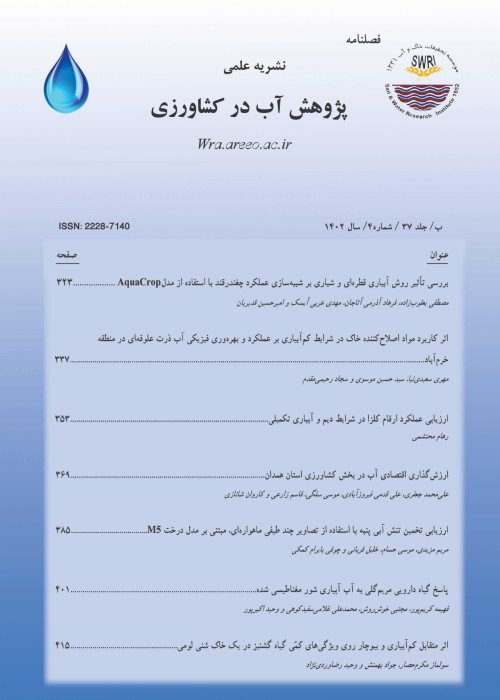Evaluation of Vertical Mixing of Saline and Fresh Water in Drainage and Its Effect on Drainage Water Salinity in Dabal Khazaei and Salman Farsi Sugarcane Farms)
In the new drainage conditions in the center and southwest of Khuzestan Province, by reducing the depth of drainage installation and controlled drainage, studying the dynamics of the mixing zone, understanding the specifications of this region, and its effect on the flow rate of drainage water and salinity is important. In this study, seven groups of piezometers, each consisting of 8 piezometers placed at different soil depths (0.8 to 5m) and at different distances from the drainage water collector were studied in two research farms, namely, field R9-11 Dabal Khazaei agro-industry (with an average drainage depth of 2 m and distances of 65 m) and field R8-7 in Salman Farsi agro-industry (with an average depth of 1.4 meters and 42 meters distances).Water level in piezometers, water salinity in different soil layers, and drainage water flow rate and salinity were monitored daily in three periods of heavy irrigation of sugarcane (March to October of 2013, 2014 and 2017). Results indicated that by starting a heavy irrigation, hydraulic head increased and hydraulic head variance between bottom layer (4 and 5 m) relative to the surface layers, established vertical flow and saline inflow upwards. Reducing the installation depth of drains up to 60 cm from in R9-11 compared to farm R8-7 and moving away from the collector up to 400 m in each farm, reduced the installation depth of drains up to 40 cm, and increased the hydraulic load by an average of 8-12 cm. The thickness of the mixing area was up to one meter and the reduction of the average salinity line in the mixing area was 8%. It was found that in addition to irrigation water salinity, drainage water salinity was affected by groundwater salinity and the difference in drainage depth, position of the impermeable layer, and the presence of sand lenses. By decreasing drainage depth, the drainage water discharge decreased sharply, such that the averag drainage water from each lateral in farm R9-11 was 10 mm/day, and in farm R8-7 it was 3.3 mm/day. The results showed that with increasing the thickness of the salt and fresh water mixing zone due to the optimal reduction of drainage depth, the volume of water consumed in each irrigation cycle decreased due to plant use of this zone, which can be an effective factor in conserving soil and water resources.
- حق عضویت دریافتی صرف حمایت از نشریات عضو و نگهداری، تکمیل و توسعه مگیران میشود.
- پرداخت حق اشتراک و دانلود مقالات اجازه بازنشر آن در سایر رسانههای چاپی و دیجیتال را به کاربر نمیدهد.


